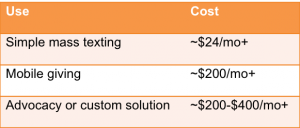After a great run, the Winning the Internet blog has been retired. However, you can still keep in touch with New Media Mentors here.
These days it’s not uncommon to hear folks touting mobile as the future of new media. It’s no surprise considering that 88% of Americans now carry a cell phone and nearly half of those folks have smartphones.1 Combine that with a few amazing case studies (like the $30+ million Red Cross raised after the catastrophic earthquake that hit Haiti2), and many nonprofits have been thirsting for more information about this promising technology.
In today’s post we’ll answer the elusive question—How much does it cost?—and break down some of the most common ways nonprofits use mobile.
Let’s get to it—how much?
Let’s cut to the chase for a minute and talk about what it costs in time and dollars to run a mobile program. The cost really depends on what you want to do.
If you’re interested in simple mass texting (ex: sending informational texts out to your list periodically, with no real expectation of any action on their part), or mobile giving (ex: text to donate $5), there are a number of self-service tools you can use to do the job. Rough estimates for ongoing costs are outlined in the table below. Actual costs will depend on the provider, volume, and how many bells and whistles you decide you need. Many services also charge a setup fee that can range from $500 to around $1,000.
If you’re interested in setting up a mobile advocacy program (using it to get folks on your list to sign petitions, make calls, etc.), the solutions tend to be less out of the box and more custom. Because of this, it’s harder to estimate the cost. It’s fair to say that advocacy tools and other custom solutions start in the $200 to $400 a month range and go up from there, depending on what you want to do.

Another important thing to consider when talking cost is the time involved in running a mobile program. I spoke with folks from a few different orgs while researching for this piece, and the consensus was that running a successful mobile program takes a real time investment.
The exact amount of time will depend on what you want to do, but it’s fair to say that it takes as much time as any other platform. It might be helpful to think about how much time your organization spends on Facebook. If you’re already struggling to find time to do everything you want to do on Facebook, you may have a tough time building out a successful mobile program.
Getting a deal and selecting a vendor
If you’re ready to dig into mobile, I suggest you spend some time outlining what you want to do (including your ultimate goals), then reach out to vendors for a price comparison. Here’s a starter list of services to check out:
Also, have an honest conversation with your team about time and expectations. If you don’t really have time to run the program yourself, consider working with an agency-style organization like Revolution Messaging that can do a lot of the work for you.
So, what can I do with it?
Organizations are doing all kinds of creative things with mobile. Here are a few possibilities to get you thinking.
- Advocacy (petitions, click to call, etc.)
- Education (informational texts like nutritional tips)
- Event info/reminders
- Info look-up (ex: find nearby locations)
- List-building (email signup)
- Small dollar donations
- Pledge to donate (larger dollar donations)
- Relatively anonymous communication with individuals
One thing to keep in mind as you brainstorm is how people are going to subscribe to your mobile list or donate. For example, if you want to start collecting small dollar mobile donations, you’re going to need a way to tell folks about it. If you don’t have access to an audience (think promotion at a concert, subway ads, etc.), then nobody’s going to use the service!
So, should I do it?
My answer is a resounding “It depends!” Mobile can be incredibly powerful part of your arsenal of tools, as long as you’ve got the funding and the time to make it work. Make sure you think about your goals, audience and have a realistic plan for promotion and maintaining the program over time. If you’ve got that figured out, go for it!
1Source: Pew Internet Digital Differences report
2Source: MobileActive.org




Comments are closed.